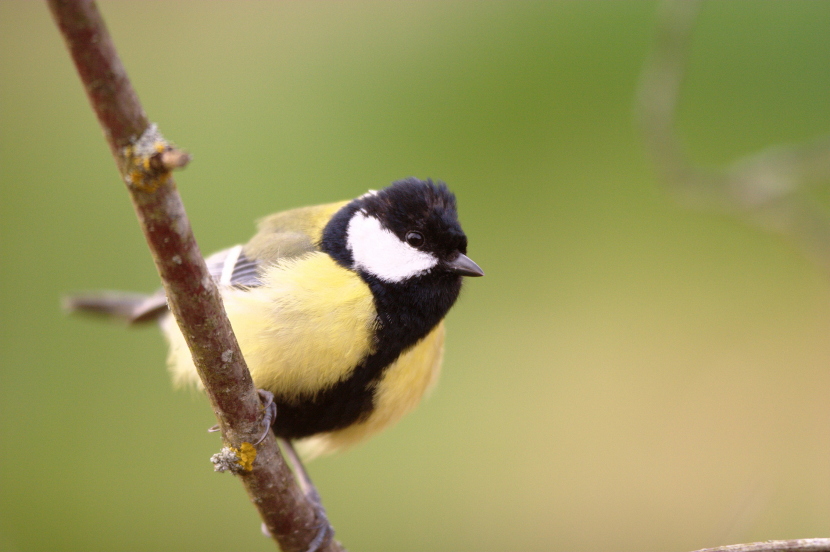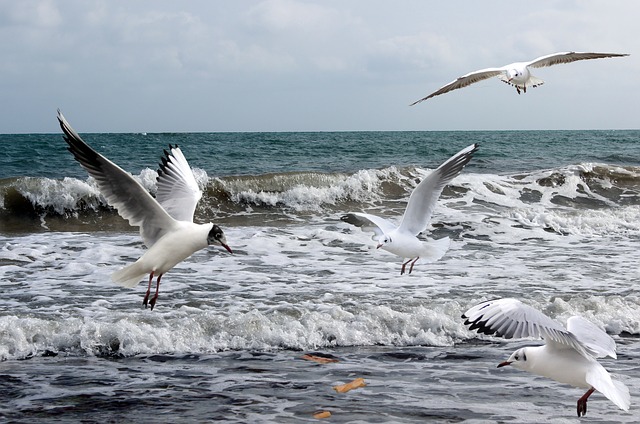Birds
Article curated by Ginny Smith
We see birds around us every day, so you might think we know all there is to know about our feathered friends – but that is far from the case! There are still many things we don't know about how birds behave, their history, and their future.
.jpg)
How do birds migrate without getting lost?


Some organisms can detect and exploit the earth’s magnetic field to help them with activities including navigation. This ability is called magnetoception. We are still not entirely sure how they do this, how it evolved, or even which species use it and to what extent. Scientists think the phenomenon may be broadly integrated across species including migratory birds and sharks.


Some researchers believe quantum entanglement might explain birds' ability to detect the earth's magnetic field. Special cells which contain proteins with entangled electrons have been found to exist in birds' eyes. When light hits these proteins, one of the entangled electrons moves just a few nanometres. This is just enough for the two electrons to feel different forces from the earth's magnetic field. Different chemicals are produced depending on these forces, and the bird ‘reads’ the chemicals, giving it a picture of the earth's magnetic field[1]. This does not, however, explain how birds know which direction to head for in the first place, and more research is needed to unentangle this mechanism.


How are human behaviours affecting birds?

Over the last 50 years, scientists in the UK have been studying a population of great tits in Oxford[2]. They found that the birds are flexible enough to adapt their behaviour to fit the changing climate. One clear indication of this is that the birds are now laying their eggs an average of 2 weeks earlier than they did 50 years ago – to fit in with peak in caterpillar numbers and ensure their young are well fed. This ability to change behaviour on shorter timescales than evolution allows means the birds could survive a change of up to 0.5 oC per year (better than the current predicted rise of 0.03 oC per year). If they didn't have this ability, there’s an estimated 60% chance they would become extinct.
Although this is good news for tits, and other short-lived, fast reproducing birds, it is unclear whether longer-lived species would adapt so well to a changing climate. This study shows that evolution alone is not enough for even tits to be able to survive the changes we are seeing in our climate. This means that any birds which do not have this flexibility in their behaviour could be in real trouble as the earth warms.
Learn more about Evolution and Climate Change.


 4
4Another way we are impacting birds is through plastic. Birds have been found with remnants of plastic bags in their stomachs, which they have presumably mistaken for food. This can be hugely damaging, but there is at least the possibility of removing large pieces of plastic from the oceans to protect wildlife. Smaller pieces of plastic, known as microplastics, however, are currently impossible to move, and we don't know what damage they might be causing.
Some microplastics have been generated directly, to use in face and body scrubs, toothpastes and other beauty products. Although microplastics are now banned from cosmetics, there are still many of them out there gradually winding their way into the environment. Small pieces of plastics may also be generated when larger pieces of plastic break down. Microplastics are often too small to be seen by the human eye and, because of their small size, they aren't filtered out during wastewater treatments. That means they wash down your plughole and straight out to sea, where they are an attractive food source for small marine animals.
We know that these plastics are having a negative effect on the animals that eat them and are getting passed up the food chain, for example in birds that eat marine animals. The big impact of microplastics is not direct impact: POPs, persistent organic pollutants dissolve well in plastics and body fats, but poorly in water, and so concentrate in plastic debris in the environment and, when animals eat them, in their tissues. POPs have negative impacts on animal and environmental health and, because they represent a range of chemicals, each poses its own unique hazards. The dangers of POPs are not fully understood.
Learn more about The impact of microplastics on sea animals.


 3
3
Cats are one of our most popular pets, with an estimated quarter of households now owning one. But compared to dogs, cats have been domesticated much more recently, so retain a lot of their wild characteristics, such as their hunting instinct. There have been few studies looking at the impact domestic cats have on wild birds and small mammals. In some regions of the world, such as Australasia, wild cat species were never present, so the introduction of pet cats has more risk of being problematic. Species they pray on are not used to avoiding them, so feral cats whose ancestors were originally brought over as pets have had a huge impact on certain native animals.
Keeping cats as pets allows the number to rise far above the maximum that would be possible for a natural population as the natural processes that normally keep predator numbers in check – e.g. access to food and territory – no longer apply. Because of this, there is concern that cats could have a destructive influence on bird numbers and diversity even in places where wild cats have long existed, although how big a problem house cats are is still unknown.
Learn more about What effects pet cats have on the ecosystem.

Humans also impact birds through intensive farming. Bird populations have declined catastrophically in agricultural areas across Europe, even amongst common, resilient species like blackbirds. With many populations down by a third, and some down by as much as 68%, pesticides are the top suspect for this sudden decline in avian numbers. Following reported decreases of up to 80% in insect populations in Germany over the last 40 years (a trend that is suspected to be worldwide), this could be because we are reducing their food supply. Alternatively, it could be because, like bees and neonicotinoids, pesticides could be directly impacting populations chemically.


Adaptions
The devastating effect of human agriculture on native bird populations is especially stunning when we consider how fast birds adapt to pressures in their environment. One example particular amongst birds is their ability to adjust the sex ratios of their offspring according to environmental pressures. For example, male offspring of the Seychelles warbler scatter and occupy new areas when they mature, whilst the females stay with their mothers and maintain their original territory. As such, when food is scarce, up to 90% of offspring is male; when food is plenty, up to 90% of offspring is female. One researcher who switched breeding pairs between high and low quality territories then observed that the sex ratios in each pair switched. Switching sex ratios ensures larger numbers of grandchildren and as such greater propagation of genes. Other animals, including deer and humans, have been reported to choose their offspring’s sex based on their own physical wellbeing.





Not all adaptions make sense though, such as the mystery of the blue footed booby. Blue footed boobies live on the tropical coastline from California to Peru, but mostly in the Galapagos. It has amazingly vivid, blue feet, which are what marks it out from closely related species like the Peruvian booby, the Red footed booby and Masked booby. In courtship, the male waves his feet in the air to show off the blueness – and the females pick the males with the bluest feet. Scientists think blueness may be a direct indicator of health. The colour is made from carotenoid pigments from their food, and so the brighter the colour, the better fed the booby. In fact, depriving a booby of food for just a couple of days causes their foot blueness to fade. Studies have also found that a chick raised by a bright-footed father (whether or not he is their biological parent) grows faster! Similarly, males are more likely to court bright footed female. If courtship continues, males go into ‘sky pointing’, arching their back and pointing their beak at the sky; it isn’t clear if this serves a benefit other than drawing attention to the individual. If the female is impressed, she will join him, and monogamous pairs sometimes repeat the ritual, suggesting it might be important in pair bonding. Perhaps the strangest part of the mating dance is when the male picks up a stick in his beak, and offers it to the female, often putting it on the floor by her feet. This is strange because boobies have no use for these sticks at all, as they don’t build nests, instead laying their eggs on the bare ground. But their cousins, the red-footed boobies do build nests, out of twigs, in bushes and trees, and so scientists have suggested that the twig used in the blue footed booby courtship display is an evolutionary leftover from when their ancestors did build nests.



Why do birds bob their heads when walking? You have probably noticed that some birds, such as chickens, bob their head as they walk, in a distinctive but rather comical motion! Some studies suggest this might be to do with vision, while others believe it could help their balance. But while researchers try to decide which of these is the more important reason, why exactly birds bob their heads remains unknown.
Learn more about Bird Head Bobbing.


 2
2One adaption that not only doesn't make sense, but seems downright stupid, is vocal hitchhiking. The male fairy wren mysteriously mimics the call of the butcher bird that preys on it when females are nearby (and only males do this). Scientists think it may be to show bravado when the female fairy wren is listening carefully, wary of the predator, and so increases his chances of mating and reproducing. However, it seems strange that this would be of evolutionary advantage as it also catches the butcher birds’ attention and results in high mortality. Quite why it’s evolved is still a mystery.


 2
2History and survival
It's possible that some bird species may go extinct – but we can't be sure which. In the past, birds have shown themselves to be very robust when it comes to extinction, their theropod ancestors miraculously surviving the mass extinction that killed off the dinosaurs 65 million years ago. Whilst there must be a biological or ecological reason for their survival, however, scientists are stumped. Lack of other "straggler" species suggest it wasn't random chance that led the birds to persist, and this makes their survival especially exciting and intrguing.

 2
2Ornithologists have uncovered interesting species in the history of birds, including dromornis stirtoni – possibly the largest bird to have ever lived on earth. Scientists have estimated that the goose-like bird stood 3 m tall and weighed 650 kg, which, if true, would exceed the weights of the giant moa of New Zealand and taller than the elephant bird of Madagascar. More is being discovered about this giant, flightless bird following digs at Alcoota near Alice Springs.





Intelligence
Birds are an intelligent species, and corvids frequently feature human research into how we measure animal intelligence. In particular, their ability to make and adapt tools, performing multiple cognitive tasks, puts them on the same intelligence level as apes, and sometimes sees them outstripping human children! But how intelligent are birds? It’s hard to say. In humans, factors like education and socioeconomic status affect performance, so measures are not necessarily a measure of “raw intelligence”, but also training. This is likely to be the same for birds. We also don’t know how widely intelligence varies individual to individual, species to species, or is affected by motivation. Find out more about interesting work on jays by Nicola Clayton at the University of Cambridge.


 2
2Some researchers have turned to their brains to better understand bird intelligence. They also reckon that bird brains and behaviour could provide insight into dinosaur intelligence and behaviours. Ostriches and emus, which have been very little studies cognitively, are probably the closest relatives to dinosaurs and could tell us the most about the ways they thought and problem-solved.


Birds have a complex and interesting language. They only use song to signal danger or seek out a mate: they can form complex sentences by stringing calls together to create new meanings and demonstrate syntax – which scientists think evolved separately in birds to in humans[3]. For tits, the instructions “come here” followed by “scan for danger” calls the whole flock, but “scan for danger” followed by “come here” causes confusion.


 2
2
Humans may get psychological benefits from connecting with nature, including mood, attention and creativity benefits. Research into biophilia has shown improved mood, cognitive function, self-esteem, reduction in blood pressure, positive impacts on immune function, and that people spend 20% more time talking when outdoors. Scientists don’t know why this is though, or which sensory perceptions dominate the effect. Is it what we see, what we smell, what we hear…? We don’t know[4].


 2
2One such way to connect with nature is listening to birdsong. The idea is sufficiently established that Alder Hey Children’s Hospital in Liverpool play birdsong in their corridors, as does an airport lounge in Amsterdam! It’s even been applied as a form of dementia treatment. This kind of treatment is known as ecotherapy. New work currently being undertaken by the National Trust aims to explore how human brains are affected by birdsong, and potentially shed light on how bird song therapy works.


 3
3This article was written by the Things We Don’t Know editorial team, with contributions from Ed Trollope, Ginny Smith, Cait Percy, Johanna Blee, and Rowena Fletcher-Wood.
This article was first published on 2015-08-27 and was last updated on 2019-06-07.
References
why don’t all references have links?
[1] Lisa Grossman, "In the Blink of a Bird's Eye, a Model for Quantum Navigation" (2011) wired.com
[2] Vedder, Oscar, Sandra Bouwhuis, and Ben C Sheldon. "Quantitative Assessment of the Importance of Phenotypic Plasticity in Adaptation to Climate Change in Wild Bird Populations" PLOS Biology 11.7 (2013): e1001605 DOI: 10.1371/journal.pbio.1001605.
[3] Griesser, Michael, David Wheatcroft, and Toshitaka N. Suzuki. From bird calls to human language: exploring the evolutionary drivers of compositional syntax. Current opinion in behavioral sciences 21 (2018): 6-12.
[4] Berman. M. et al. (2012). Interacting with Nature Improves Cognition and Affect for Individuals with Depression. Journal of Affect Disorder. 2012 Nov;140(3):300.
Recent birds News
Get customised news updates on your homepage by subscribing to articles








.jpg)





